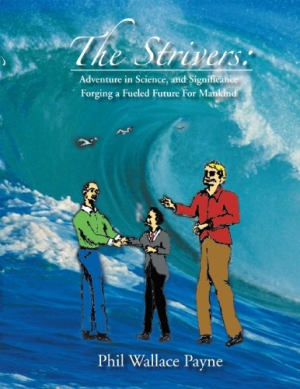The Strivers
Adventure in Science, and Significance Forging a Fueled Future for Mankind
Today, it is widely accepted that humanity must begin to explore and utilize renewable sources of energy. In Phil Wallace Payne’s debut novel, The Strivers: Adventure in Science, and Significance Forging a Fueled Future for Mankind Book II, which is set in the 1970s, sources of alternative energy are being developed in secret by a wealthy group of individuals called the Ephasians. The Ephasians tap brilliant scientist Max Ernst to build a floating structure that is big enough for human habitation for the scientists and their families and capable of generating its own energy from ocean waves. The work must be done clandestinely because Max and the Ephasians fear that attention from the news media would undermine their efforts.
During his career as a rocket scientist, sailor, and world traveler, Payne gained a detailed knowledge of fuel sources, oceanography, and foreign languages. He uses his knowledge to propose a convincing solution to the world’s power woes by harnessing renewable energy from the power of endlessly crashing waves. Eventually, all humans would live on floating structures such as the one Max and his team are creating, thereby eliminating the need for anything than runs on fossil fuels. Payne’s protagonist, Max, whose genius comes across as extreme, is a relatable character because of his personal experiences of great loss and sorrow. In light of the recent “Occupy” movement, some readers may warm to the Ephasians, who use their riches to benefit the world, not just themselves.
For all it hopes to be, however, The Strivers falls short. The reader wonders whether the book contains the fictionalized accounts of the work of actual scientists or serves as a thinly veiled treatise on the energy crisis. To add to the confusion, the book’s bulky size, glossy pages with borders, and the very small size of its type give it the appearance and heft of a high-school textbook. Unnecessary capitalization, missing quotation marks, awkward phrasing, hand-drawn figures on the cover, and the clip-art images without adequate captions inside the book also undermine the seriousness of Payne’s topic.
The book additionally flounders as Payne crams in too many characters to remember, too much scientific detail, and precious little plot structure. Scientific details and extensive discussions on a variety of social ills slow forward momentum, as the characters explain every single facet of the floating structure and take the time to excoriate capitalism and the press. Such speeches grow tiresome, as readers wait for something to happen.
When action scenes do occur, they seem awkwardly squished into the story, as though Payne occasionally remembers he needs to have his characters do more than simply serve as mouthpieces for his ideas. Only die-hard science buffs may be able to overlook the serious flaws in the production of The Strivers.
Reviewed by
Jill Allen
Disclosure: This article is not an endorsement, but a review. The publisher of this book provided free copies of the book and paid a small fee to have their book reviewed by a professional reviewer. Foreword Reviews and Clarion Reviews make no guarantee that the publisher will receive a positive review. Foreword Magazine, Inc. is disclosing this in accordance with the Federal Trade Commission’s 16 CFR, Part 255.

